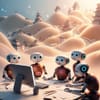The emergence of AI filters that mimic the iconic Studio Ghibli aesthetic has sparked intense debates about art, originality, and accessibility. The trend of "Ghiblification" began with OpenAI's GPT- and can transform ordinary photos into images resembling Studio Ghibli's signature style, echoing the studio's iconic films such as Spirited Away and My Neighbor Totoro.
However, the use of AI to replicate Ghibli's style raises several concerns. One of the primary issues is copyright and consent, with artists arguing that their styles are being exploited without compensation or credit. The question remains whether AI models can use copyrighted artwork without permission.
Another concern is artistic integrity, with some viewing AI-generated art as a form of plagiarism, while others see it as a new form of artistic expression. The impact on artists is also a significant concern, with the animation industry already exploring AI for tasks like background art and in-betweening.
The controversy surrounding Ghibli-style AI art has sparked intense discussions about the role of AI in art and the importance of respecting artistic intent. While some see AI as a tool for creative exploration, others argue that it must be used responsibly and with consideration for the original creators.
As the debate continues, it's clear that the intersection of AI and art will be a complex and evolving issue. The question remains whether AI will replace human artists or devalue their work, or if it can be a force for creative innovation. The answer to this question will have significant implications for the future of art and the role of AI in the creative process.


